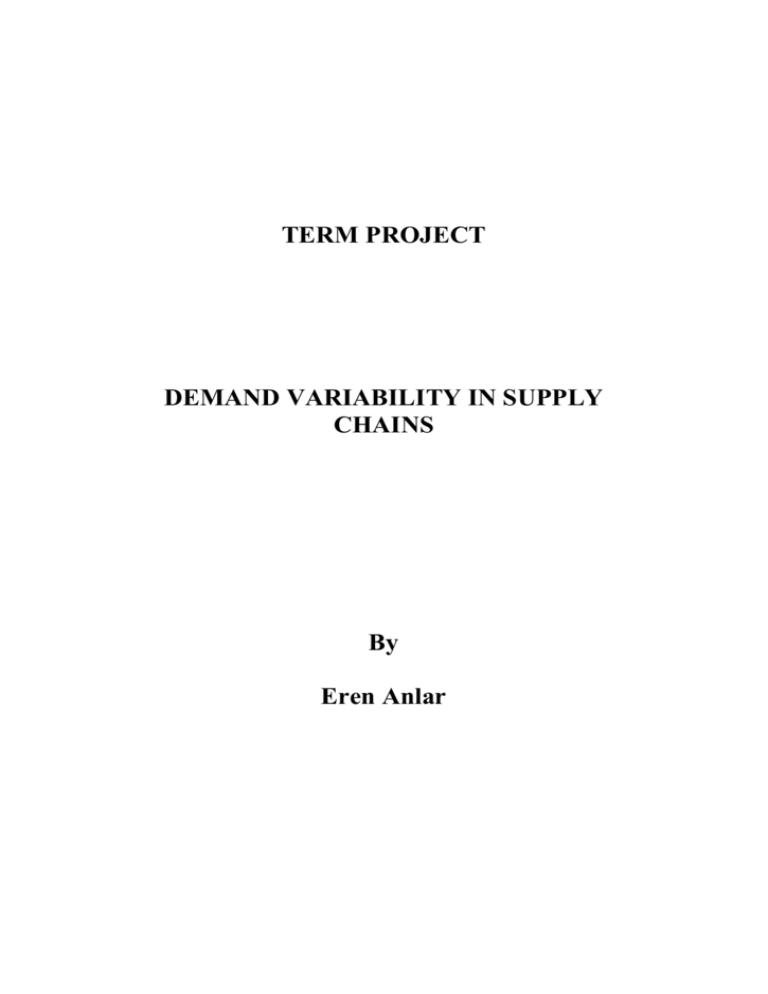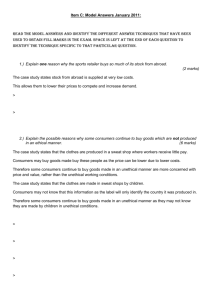Expectation of the proposed model
advertisement

TERM PROJECT DEMAND VARIABILITY IN SUPPLY CHAINS By Eren Anlar Introduction This paper considers supply chain demand variability. It consists of concepts and related literature review. Finally, a related research area is proposed. The proposition consists of the assumptions, the model and the solution methodology. Concepts Scheduled ordering: the retailers may order only every T periods, and their order quantities must equal an integer multiple of a fixed batch size, Qr. Synchronized ordering occurs when all N retailers order in the same periods, every T periods. Balanced ordering occurs when equal number of retailers order per period. Flexible Quantity Strategy: Increasing T and decreasing Qr. This enables the retailer to have more flexibility to choose the order quantity, but less flexibility in the timing of orders. Literature Review Eppen and Schrage (1981) study a two-echelon model in which the supplier receives inventory at fixed intervals. Deuermeyer and Schwarz (1981) and Svoronos and Zipkin (1988) provide techniques to approximate average costs in a continuous review model with Poisson demand. Both of them assume no restrictions on when the retailers may order. Shapiro and Byrnes (1992) empirically examine demand variance in the medical supply industry and observe that final demand exhibits little fluctuation, but that orders from hospitals exhibit dramatic variability. Their results suggest that reducing the supplier’s demand variance may benefit a supply chain. Axsater (1993) provides exact methods to approximate average costs in a continuous review model with Poisson demand under the assumption that no restrictions on when retailers may order. Song (1994) showed, for a particular definition of demand variability, that the buffer cost will increase with increasing variability. Lee et al. (1996) assume synchronized ordering, and retailer orders are always filled either by the supplier or an outside. Therefore, the supplier’s actions do not impact the retailers, nor do the retailers’ actions influence the supplier’s demand variance. Cachon and Lariviere (1996) studied shortage gaming. Chen and Samroengraja (1996) obtain exact results for a model in which retailers implement base stock policies at fixed intervals and only one retailer orders at a time. Their work provides exact results with batch ordering. Fisher and Raman (1996) consider a Quick Response system, an apparel industry initiative intended to cut manufacturing and distribution lead times through a variety of means, particularly the cost of excess inventory that must be sold below cost at the end of the season and of lost sales due to inventory stockouts. They showed that Quick Response could reduce stockout and markdown costs by reducing lead time sufficiently to allow a portion of production to be committed after some initial demand has been observed. Drezner et al. (1996) and Chen et al. (1997) studied demand updating. Lee et al. (1997) identified the four causes of the bullwhip effect (i.e. the name given to the common observation that demand variance propagates up a supply chain): synchronized ordering (all retailers order in the same periods), shortage gaming (retailers inflate their orders to receive a better allocation), demand updating (the supplier is unaware of true retailer demand and so must rationally assume a higher variance), and price fluctuations (retailers purchase more than their short term 2 needs to take advantage of temporary price discounts). Chen and Zheng (1997) provide exact methods to approximate average costs in a continuous review model with Poisson demand by assuming no restrictions on when retailers may order. Cohen and Baganha (1998) considered supply chain demand variance, but they do not consider strategies for reducing the variance of the retailers’ orders. Aviv and Federgruen (1998) consider both synchronized and balanced alignments and find that balanced ordering generally has lower costs. Their model has heterogeneous retailers and a supplier capacity constraint. Cachon (1999) considers five variables that influence the supplier’s demand variance. Two of them are structural: consumer demand variability and the number of retailers. The other three are policy parameters: the retailers’ batch size, the retailers’ order interval length, and the alignment of the retailers’ order intervals. Kelle et al. (1999) conclude that negative effect of high variability and uncertainty can be decreased by small frequent orders. These orders are economical for the partners in the supply chain if the ordering costs are small relative to the inventory holding cost. Ridder et al. (1999) considers a Newsvendor problem and concludes that reduction of the demand uncertainty in stochastic production and inventory systems is economically favorable for most demand distributions. However, for some demand distributions a reduction of the demand uncertainty will not result in the desired cost reduction. Federgruen and Zipkin (1984), Jackson (1988), Jackson and Muckstadt (1989), McGavin et al. (1993), Nahmias and Smith (1994) and Graves (1996) allow shipments to retailers at intermediate times between replenishments to the supplier, allowing the supplier to hold some stock. Their models assume synchronized ordering and unit ordering. They conclude that the variability of supplier demand has no impact, since the supplier is concerned only with the total amount of inventory needed at the start of each interval. Research Analysis The research area is consideration of a supply chain demand variability in a model with one supplier and N retailers and with various demand distributions. Demand distributions that are considered are: Lognormal, Weibull and Beta. This section describes the proposed research area in detail. The specific questions to be analyzed are below: 1) Effect of switching from synchronized order intervals to balanced order intervals on holding and backorder costs. 2) Effect of increasing T on the variability of a single retailer’s order process. 3) Effect of increasing T on average % increase in holding and backorder costs (relative to T=1). 4) Effect of Flexible Quantity Strategy on holding and backorder costs. 5) Effect of Flexible Quantity Strategy on holding and backorder costs when the supplier is required to provide a high (above 90%) fill rate. 3 Notation N = number of retailers p Dr consumer demand over p periods hr = cost per unit of retailer inventory per period hs = cost per unit of retailer inventory per period pr = cost per retailer backorder per period C = average supply chain costs per period = N (hr EI r pr EBr hs Qr EI s For each location I, the following are defined after demand occurs (event 1) but before orders are submitted (event 2): on-hand inventory, Ii; backorders, Bi; on hand inventory, OIi; and inventory position, IPi= Ii - Bi + OIi. On-order inventory is inventory ordered but not received. IPi* = inventory position just after the firms order (event 2) OPi* = on-order inventory just after firms order (event 2) Assumptions p 1) There exists a finite d such that Pr Dr d =1. 2) The supplier randomly shuffles the retailers’ orders for that period. 3) T N 4) m* is an integer 5) Holding costs for on-route inventory are ignored. Model One supplier distributes a single product to N identical retailers. The retailers implement scheduled ordering policies. The sequence of events within each period: 1) Demand is realized 2) Firms submit orders to their inventory sources 3) Shipments are released 4) Costs are assessed 5) Shipments are received Consumer demand is non-negative, stationary, discrete, and independent across periods. The retailers can order in review periods, which occur every T periods. Retailers follow a scheduled ordering policy: In any review period when IPr Rr, a retailer orders a sufficient integer multiple of Qr units to raise IPr above Rr. Batch size is Qr. The supplier follows an (Rs, nQs) policy, which is analogous to retailers’ policy, except the supplier may order in any period. Since the supplier’s demand equals an integer number of batches, all supplier variables are measured in batches of inventory. The supplier’s orders are always received in Ls periods. Inventory shipped from the supplier in period t arrives at a retailer in period t + Lr. Unfilled demands are backordered, and all backorders are eventually filled. Since the supplier may receive orders from several retailers within a period, the supplier must allocate inventory among retailers. The supplier shuffles the retailers’ orders for that period without giving preference to any retailer. The orders are then placed in an order queue. Orders are filled from this queue on a first-in-first –out basis. Then the supplier partially ships a retailer order. Balanced orders are possible 4 only when N is an integer multiple of T. m* = N/T, therefore, m* retailers order each period. Expectation of the proposed model If we were to change from synchronized order intervals to balanced order intervals, the supply chain holding cost and backorder cost will decrease. The existence of consumer demand makes the supplier to carry safety stock to guarantee reliable deliveries. If balanced orders are implemented, the supplier’s demand variance will decline as T is increased and the average % increase in holding and backorder costs relative to T =1, will be significant. Hence, lengthening the retailers’ order intervals reduces the supplier’s demand variability but increases supply chain holding and backorder costs. Also, it will reduce the retailer’s ordering frequency, leading to a reduction in ordering costs. Generally, a flexible quantity strategy will reduce supply chain costs when there are few retailers and low consumer demand variability. However, if either consumer demand variability or the number of retailers were to increase this strategy will lose its effectiveness. Reducing the supplier’s demand variance through a flexible quantity strategy is most effective when the supplier is required to offer a high fill rate. References 1) Aviv, Y., Federgruen, A, “The operational benefits of information sharing and vendor managed inventory (VMI) programs”, Working Paper, Olin School of Business, Washington University , St. Louis, MO, 1998 2) Ridder, A., Van Der Laan, E., Salomon, M., “How larger demand variability may lead to lower costs in the Newsvendor problem”, Operations Research v.46, No.6, Nov.-Dec. 1998. 3) Fisher, M., Raman, A., “Reducing the cost of demand uncertainty through accurate response to early sales”, Operations Research, v.44, No. 1, Jan.-Feb. 1996. 4) Jackson, P., “Stock allocation in a two-echelon distribution system or “What to do until your ship comes in””, Management Science, v.34, No. 7, July 1988. 5) Lee, H.L., Padmanabhan, V., Whang, S., “ The Bullwhip Effect in supply chains”, Sloan Management Review, Spring 1997. 6) Cachon, G., “Managing supply chain demand variability with scheduled ordering policies”, Management Science, v.45, No. 6, June 1999. 7) Dejonckheere, J., Disney, S. M., Lambrecht, M. R., Towill, D. R., “Measuring and avoiding the bullwhip effect: A control theoretic approach”, European Journal of Operational Research, 147 (2003) 567-590. 8) Kelle, P., Milne, A., “The effect of (s, S) ordering policy on the supply chain”, Int. J. Production Economics, 59 (1999) 113-122. 9) Song, J. “ The effect of leadtime uncertainty in a simple stochastic inventory model”, Management Science, v.40, No. 5, May 1994. 10) Axsater, S., “ Exact and approximate evaluation of batch-ordering policies for two-level inventory systems”, Operations Research, v. 41, No.4, July-August 1993. 11) Xu, K., Dong, Y., Evers, T. P., “ Towards better coordination of the supply chain”, Transportation Research, Part E 37, 2001, 35-54. 5 12) Chen, F., Zheng, Y., “ One-warehouse multiretailer systems with centralized stock information”, Operations Research, v. 45, No. 2, Mar.-Apr. 1997. 13) Eppen, G., Schrage, L., “Centralized ordering policies in a multi-warehouse system with lead times and random demands”, TIMS Studies in the Management Sciences, 16 51-67, 1981. 14) Deuermeyer, B., Schwarz, L., “ A model for the analysis of system service level in warehouse-retailer distribution systems: the identical retailer case”, TIMS Studies in the Management Sciences, 16 163-193, 1981. 15) Federgruen, A., Zipkin, P., “ Computational issues in an infinite horizon, multiechelon inventory model”, Operations Research, 32,818-836, 1984. 16) Shapiro, R., Byrnes, J., “ Intercompany operating ties: unlocking the value in channel restructuring”, Working Paper, Harvard Business School, Cambridge, MA, 1992. 17) McGavin, E., Schwarz, J., “ Two-interval inventory allocation policies in a one-warehouse N-identical retailer distribution system”, Management Science, 39, 1092-1107, 1993. 18) Nahmias, S., Smith, S., “ Optimizing inventory levels in a two echelon retailer system with partial lost sales”, Management Science, 40,582-596, 1994. 19) Svoronos, A., Zipkin, P., “ Estimating the performance of multi-level inventory systems”, Operations Research, 36, 57-72, 1988. 20) Cohen, M., Baganha, M., “ The stabilizing effect of inventory in supply chains”, Operations Research, 46, S72-S83, 1998. 21) Graves, S., “ A multiechelon inventory model with fixed replenishment intervals”, Management Science, 42, 1-18, 1996. 6









